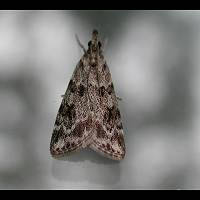Eudonia truncicolella
Eudonia truncicolella is very hard to tell apart from various related Pyralids, all small, black and white and similarly marked. There are even more species just like these, but they are rare or even very rare. Characteristics for the three species are as follows:
The black spot resembling an x, usually looks like an x, just like it does in Scoparia ambigualis. However in Dipleurina lacustrata it does look more like a c. The wings of Scoparia ambigualis are broader than those of the other two species. The dark line just in front of of the white is best developed in D. lacustrata, less so in Scoparia ambigualis and least in Dipleurina lacustrata.Compared to Scoparia ambigualis Eudonia truncicolella is rather black and white lacking brownish tones so visible in Scoparia ambigualis. Eudonia truncicolella doesn't fly in May and the first half of June, Scoparia ambigualis however does.
Do keep in mind though that you can never be sure, for especially Scoparia ambigualis is very variable. The only way to tell them apart for sure is by examining the genitals. And when you are a beginner do take good pictures and present them to experienced microlepidopterists.
Eudonia truncicolella flies in July and August and the larvae can be found on various species of mosses. They live in a silken tube. The wingspan of Eudonia truncicolella varies from 18 to 23 mm. It's locally common on mainland Britain and in Ireland.
Eudonia truncicolella is very hard to tell apart from various related Pyralids, all small, black and white and similarly marked. There are even more species just like these, but they are rare or even very rare. Characteristics for the three species are as follows:
The black spot resembling an x, usually looks like an x, just like it does in Scoparia ambigualis. However in Dipleurina lacustrata it does look more like a c. The wings of Scoparia ambigualis are broader than those of the other two species. The dark line just in front of of the white is best developed in D. lacustrata, less so in Scoparia ambigualis and least in Dipleurina lacustrata.Compared to Scoparia ambigualis Eudonia truncicolella is rather black and white lacking brownish tones so visible in Scoparia ambigualis. Eudonia truncicolella doesn't fly in May and the first half of June, Scoparia ambigualis however does.
Do keep in mind though that you can never be sure, for especially Scoparia ambigualis is very variable. The only way to tell them apart for sure is by examining the genitals. And when you are a beginner do take good pictures and present them to experienced microlepidopterists.
Eudonia truncicolella flies in July and August and the larvae can be found on various species of mosses. They live in a silken tube. The wingspan of Eudonia truncicolella varies from 18 to 23 mm. It's locally common on mainland Britain and in Ireland.




